Demographics
The SA1 statistical area which includes Panguru covers 11.18 km2 (4.32 sq mi). [1] The SA1 area is part of the larger Hokianga North statistical area.
Historical population for Panguru| Year | Pop. | ±% p.a. |
|---|
| 2006 | 105 | — |
|---|
| 2013 | 93 | −1.72% |
|---|
| 2018 | 96 | +0.64% |
|---|
| Source: [2] |
The SA1 statistical area had a population of 96 at the 2018 New Zealand census, an increase of 3 people (3.2%) since the 2013 census, and a decrease of 9 people (−8.6%) since the 2006 census. There were 48 households, comprising 42 males and 51 females, giving a sex ratio of 0.82 males per female. The median age was 52.2 years (compared with 37.4 years nationally), with 18 people (18.8%) aged under 15 years, 9 (9.4%) aged 15 to 29, 42 (43.8%) aged 30 to 64, and 24 (25.0%) aged 65 or older.
Ethnicities were 15.6% European/Pākehā, 87.5% Māori, and 6.2% Pacific peoples. People may identify with more than one ethnicity.
Of those people who chose to answer the census's question about religious affiliation, 9.4% had no religion, 81.2% were Christian and 3.1% had Māori religious beliefs.
Of those at least 15 years old, 9 (11.5%) people had a bachelor's or higher degree, and 18 (23.1%) people had no formal qualifications. The median income was $17,400, compared with $31,800 nationally. 3 people (3.8%) earned over $70,000 compared to 17.2% nationally. The employment status of those at least 15 was that 18 (23.1%) people were employed full-time, 15 (19.2%) were part-time, and 6 (7.7%) were unemployed. [2]
Hokianga North statistical area
Hokianga North statistical area covers the western side of the area between Hokianga Harbour and Whangape Harbour, including the locality of Matihetihe. It has an area of 345.94 km2 (133.57 sq mi) [1] and had an estimated population of 980 as of June 2022, [5] with a population density of 2.8 people per km2.
Historical population for Hokianga North| Year | Pop. | ±% p.a. |
|---|
| 2006 | 813 | — |
|---|
| 2013 | 744 | −1.26% |
|---|
| 2018 | 795 | +1.33% |
|---|
| Source: [6] |
Hokianga North had a population of 795 at the 2018 New Zealand census, an increase of 51 people (6.9%) since the 2013 census, and a decrease of 18 people (−2.2%) since the 2006 census. There were 294 households, comprising 399 males and 396 females, giving a sex ratio of 1.01 males per female. The median age was 42.6 years (compared with 37.4 years nationally), with 201 people (25.3%) aged under 15 years, 120 (15.1%) aged 15 to 29, 312 (39.2%) aged 30 to 64, and 159 (20.0%) aged 65 or older.
Ethnicities were 25.3% European/Pākehā, 86.0% Māori, 7.5% Pacific peoples, 0.8% Asian, and 0.4% other ethnicities. People may identify with more than one ethnicity.
The percentage of people born overseas was 3.8, compared with 27.1% nationally.
Of those people who chose to answer the census's question about religious affiliation, 16.2% had no religion, 73.6% were Christian and 4.2% had Māori religious beliefs.
Of those at least 15 years old, 48 (8.1%) people had a bachelor's or higher degree, and 168 (28.3%) people had no formal qualifications. The median income was $17,900, compared with $31,800 nationally. 30 people (5.1%) earned over $70,000 compared to 17.2% nationally. The employment status of those at least 15 was that 150 (25.3%) people were employed full-time, 93 (15.7%) were part-time, and 54 (9.1%) were unemployed. [6]
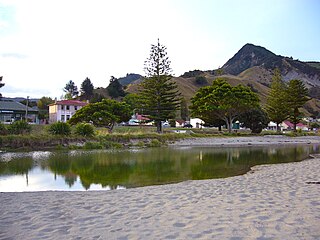
Tokomaru Bay is a small beachside community located on the isolated East Coast of New Zealand's North Island. It is 91 km north of Gisborne, on State Highway 35, and close to Mount Hikurangi. The district was originally known as Toka-a-Namu, which refers to the abundance of sandflies. Over the years the name was altered to Tokomaru Bay.

Murupara is a town located in the Whakatāne District and Bay of Plenty Region of New Zealand's North Island. The town is situated in an isolated part of the region between the Kaingaroa Forest and Te Urewera protected area, on the banks of the Rangitaiki River, 65 kilometres southeast of Rotorua. Indigenous Māori also make up over 90% of the total population.
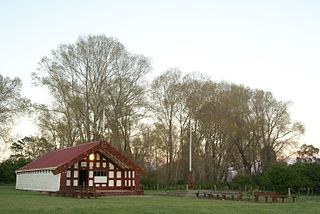
Ruatoria is a town in the Waiapu Valley of the Gisborne Region in the northeastern corner of New Zealand's North Island. The town was originally known as Cross Roads then Manutahi and was later named Ruatorea in 1913, after the Māori Master female grower Tōrea who had some of the finest storage pits in her Iwi at the time (Te-Rua-a-Tōrea). In 1925 the name was altered to "Ruatoria", although some texts retain the original spelling.

Tolaga Bay is both a bay and small town on the East Coast of New Zealand's North Island located 45 kilometres northeast of Gisborne and 30 kilometres south of Tokomaru Bay.

Dame Whina Cooper was a respected kuia, who worked for many years for the rights of her people, and particularly to improve the lot of Māori women. She is remembered for leading the 1975 Māori land march from Te Hapua to Wellington, a distance of 1,100 km (680 mi), at the age of 79.
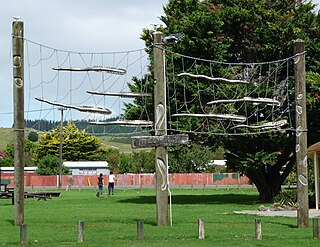
Moerewa is a small town in the Northland Region of the North Island of New Zealand. It is located close to the Bay of Islands five kilometres to the west of Kawakawa.

Matauri Bay is a bay in New Zealand, situated 30 km north of Kerikeri, in Whangaroa county, just north of the Bay of Islands. It has over a kilometre of white sand and crystal clear water, making it a popular summer destinations for surfers, divers, fishers and holidaymakers.

Opononi is a settlement on the south shore of Hokianga Harbour in Northland, New Zealand. State Highway 12 runs through Opononi. Ōmāpere is on the shore to the south of Opononi and Pakanae to the northeast.

Ngawha Springs is a small settlement and hot water springs approximately five kilometres east of the town of Kaikohe in Northland, New Zealand. Ngāwhā means "boiling spring".
Te Teko is a small inland town along the banks of the Rangitaiki River in the Bay of Plenty region of New Zealand's North Island.

Kohukohu is a village on the Hokianga Harbour in the Northland Region of New Zealand. It was one of the first European settlements in New Zealand.

Ahipara is a town and locality in Northland, New Zealand at the southern end of Ninety Mile Beach, with the Tauroa Peninsula to the west and Herekino Forest to the east. Ahipara Bay is to the north west. Kaitaia is 14 km to the north east, and Pukepoto is between the two.

Herekino is a locality in Northland, New Zealand. It lies 26 km south west of Kaitaia. The Herekino Harbour, also called the Herekino River, is an estuary and inlet from the Tasman Sea to the west. The Herekino Forest, which contains a stand of large kauri, is to the north, and the Tauroa Peninsula lies to the north west.

Horeke is a settlement in the upper reaches of the Hokianga Harbour in Northland, New Zealand. Kohukohu is just across the harbour. The Horeke basalts are located near the town, and can be viewed on an easy stroll through the Wairere Boulders, a commercial park.
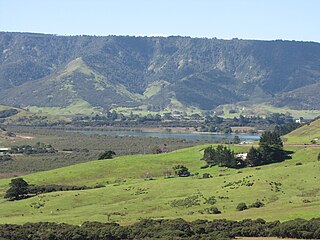
Whangape Harbour is a harbour on the west coast of Northland, New Zealand. There is a settlement called Whangape on the northern side of the harbour. Another, called Pawarenga, is located on the southern side. Kaitaia is 42 km north east.
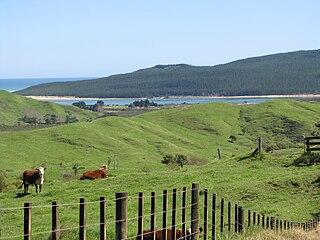
Te Rarawa is a Māori iwi of Northland, New Zealand. The iwi is one of five Muriwhenua iwi of the far north of the North Island.
Waioeka is a rural community in the Ōpōtiki District and Bay of Plenty Region of New Zealand's North Island. It is on the east bank of the Waioeka River.
Okauia is a rural settlement and community located east of Matamata, in the Waikato region of New Zealand's North Island.

Rotoiti is a settlement on the shore of Lake Rotoiti, in Rotorua Lakes within the Bay of Plenty Region of New Zealand's North Island.
Waitahanui is a village in the Taupō District, Waikato region, New Zealand. The village is on the eastern shore of Lake Taupō, 14 km (9 mi) south of the district seat of Taupō.
















